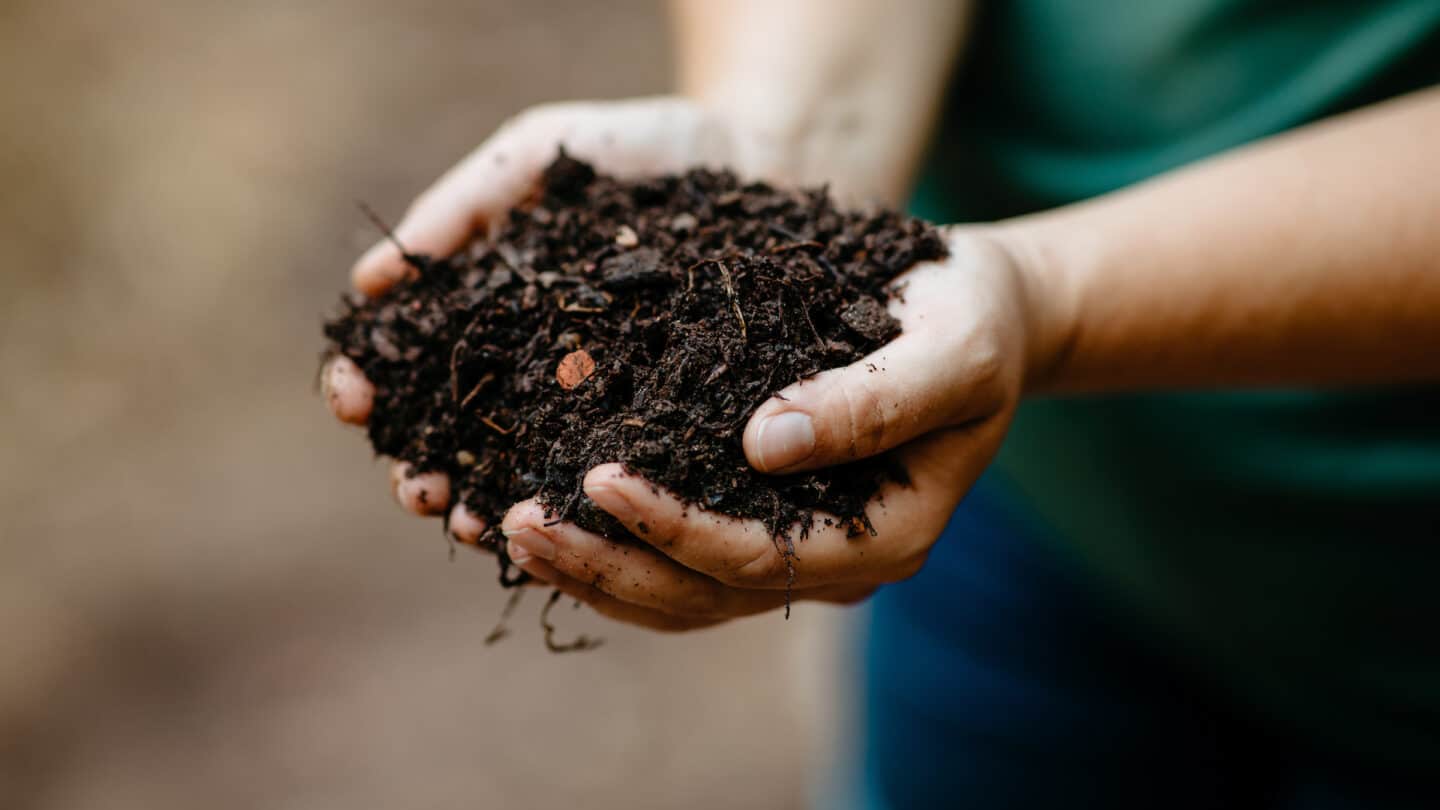
Recycling.
Recycling is a standard operating procedure at Atlanta History Center. Recycling containers are prominently placed in strategic locations around the property for cans, bottles, and other smaller items. Office supplies such as copy paper, envelopes, poster board, newspapers, and magazines are recycled as well.
Compost Program.
Since 2017, our Goizueta Gardens staff has cultivated a compost program where they blend produce scraps from Souper Jenny with animal waste from Smith Farm. The compost is used extensively across Atlanta History Center grounds to improve clay soils and aid struggling plants.
Integrated Pest Management.
Within Goizueta Gardens, we focus on pest prevention by building healthy soils and cultivating plants that are well-suited to our environment. Our staff inspects our living collections daily for signs of pests and disease, monitoring existing problem areas and constantly reassessing the best intervention strategies. We use physical controls wherever possible, reserving judicious use of chemical controls as a last resort.
IPM helps us keep our plants healthy while maintaining a healthy environment, all while reducing expenses. As members of the Sentinel Plant Network, our staff members are trained in early detection of high consequence plant pests and diseases. To learn more about scouting and reporting high-consequence pests, check out the First Detector program of the National Plant Diagnostic Network.
Sustainable Buildings.
Having a green footprint is a priority for Atlanta History Center. In recent years, we made great strides towards improving the energy efficiency of our buildings and reducing water consumption.
Improvements to heating, ventilation, lighting, and air conditioning have resulted in an annual energy reduction of nearly a quarter, with Atlanta History Center directing saved dollars into exhibitions, school programs, initiatives, and events central to our core mission. These improvements have been achieved in part by the History Center’s participation in Southface’s GoodUse program (which helps nonprofits reduce utility usage and save dollars).
Reducing water consumption has also been a key goal. High-efficiency touchless plumbing fixtures have helped us reduce water use and improve the cleanliness of our facilities.
New technologies are helping Atlanta History Center save on energy and reduce its carbon footprint. For instance, as part of a renewal project in 2022, we installed a new air conditioning chiller on the Museum building which will save up to 40% on operating costs. The new chiller features modern high efficiency magnetic bearing compressors and replaces a 30-year-old machine which uses traditional oil-lubricated bearings.
Sustainable New Construction.
Much work went into ensuring that the Lloyd and Mary Ann Whitaker Cyclorama Building became a suitable showcase for the 130-year-old The Battle of Atlanta cyclorama painting, one of the city’s most treasured historic artifacts, and the newest major construction project at Atlanta History Center. Located at the corner of West Paces Ferry Road and Slaton Drive in Buckhead, the building has been outfitted with energy-efficient HVAC equipment, LED lighting, and recycled materials. More than 1,000 tons of recycled concrete milled into crushed stone were used to enable Atlanta History Center to create a below-grade drain around the entire rotunda housing The Battle of Atlanta painting. As part of the project, Atlanta History Center added drainage/retention pits and bioswales (a drainage course with gentle sloped and vegetation-filled sides) at the nearby Smith Farm to help capture and filter runoff. Also, a 5,000-gallon cistern near the front of Atlanta History Museum was added as part of Cyclorama construction, allowing, for the first time, the use of runoff storm water for irrigation.
Pollinator Habitat.
Our thirty-three acres of gardens and woodland provide an abundance of habitat for pollinators, and tens of thousands of flowering plants that bloom throughout the year, with an emphasis on Georgia’s native plants. We are very strict in our use of pesticides, in accordance with our IPM strategy. Some of the best butterfly and other pollinator viewing sites are the wildflower meadow adjacent to the Wood Cabin in Swan Woods in summer and early fall. It is planted with Georgia Piedmont natives that include monarch larval host plants and favorite flowers to support our four honey bee hives. Another thriving pollinator site is the Entrance Gardens, with plants specifically selected to support native pollinators with an abundance of pollen, nectar, hollow stems for overwintering, and other habitat management practices.
Wild Fauna.
Goizueta Gardens is an oasis in the city for Atlanta’s wild fauna. We are registered as a Wildlife Sanctuary by the Georgia Audubon Society and host their bird walks several times a year; to date, we have counted over 60 different species of birds. In addition to numerous pollinating insects, we are now surveying the variety of amphibians and reptiles here including salamanders, lizards, turtles, toads and frogs and work with our partners at the Amphibian Foundation to increase populations of vulnerable species. Occasionally we are visited by deer, rabbits, foxes, coyotes, raccoons and other mammals, and have installed wildlife cameras in a few locations, particularly to spot any coyotes, in collaboration with the Atlanta Coyote Project.
Learn. More.
-
Story
Here are five of our best green practices with some tips on how you can do them at home.
-
Story
As a community-based organization with a dedication to connecting people, history, and culture, Atlanta History Center is committed to showing up and serving the city of Atlanta with the resources we have available.
-
Buildings & Grounds
Explore highlights of Southeastern horticultural history by taking in 33 acres of enchanting gardens, woodlands, and trails.

